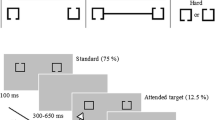Children of early school age (8.0 ± 0.1 years) were separated on the basis of EEG characteristics into the following groups: 1) those with normal development of the frontothalamic selective attention system (n = 21) and 2) those with functional immaturity of the frontothalamic system due to delays in its development (n = 29). The Uznadze paradigm was used to form a set to nonverbal visual stimuli (circles of different sizes). The set was rigid in most group 2 children. The coherence of cortical electrical potentials in the theta, alpha, and beta ranges recorded from the frontal, central, temporal, parietal, and occipital areas was analyzed. Intergroup differences were most marked at the set actualization stage in children with plastic sets: the coherence of potentials between the anterior and posterior zones was significantly more marked in subjects with immature frontothalamic systems than in the “normal” group. The relationship between the level of coherence of potentials with set plasticity was more defined in the “frontothalamic” group than in the control group. Rigid sets were associated with significantly lower levels of coherence of potentials in all ranges as compared with the baseline EEG with the eyes open. The increase in the coherence of theta potentials on set actualization occurring mainly in the right hemisphere in the “frontothalamic” group was interpreted as a measure of the compensatory increase in the role of the corticohippocampal system to support set plasticity.
Similar content being viewed by others
References
E. A. Kostandov, “Importance of the context of cognitive activity in the formation of unconscious visual sets,” Ros. Fiziol. Zh., 92, No. 2, 164–177 (2006).
E. A. Kostandov, E. A. Cheremushkin, and M. L. Ashkinazi, “Characteristics of a visual nonverbal set in children of preschool and early school age,” Zh. Vyssh. Nerv. Deyat., 55, No. 3, 347–352 (2005).
E. A. Kostandov, D. A. Farber, E. A. Cheremushkin, R. I. Machinskaya, N. E. Petrenko, and M. L. Ashkinazi, “Spatial organization of cortical electrical activity at different stages of a visual set in children of preschool and early school age,” Zh. Vyssh. Nerv. Deyat., 57, No. 6, 689–698 (2007).
E. A. Kostandov, D. A. Farber, E. A. Cheremushkin, R. I. Machinskaya, N. E. Petrenko, and M. L. Ashkinazi, “The visual set and attention-switching function in 8-year-old children with EEG signs of immaturity of the frontothalamic and brainstem activatory systems,” Zh. Vyssh. Nerv. Deyat., (2009), 59.
I. P. Lukashevich, R. I. Machinskaya, and M. N. Fishman, “Diagnosis of the functional state of the brain in children of early school age with learning difficulties,” Fiziol. Cheloveka, 20, No. 5, 34–45 (1995).
R. I. Machinskaya, “Functional maturation of the brain and the formation of the neurophysiological mechanisms of selective voluntary attention in children of early school age,” Fiziol. Cheloveka, 32, No. 1, 1–11 (2006).
R. I. Machinskaya and O. A. Semenova, “Characteristics of the formation of higher mental functions in children of early school age with different levels of maturity of the regulatory systems of the brain,” Zh. Evolyuts. Biokhim. Fiziol., 40, No. 5, 427–435 (2004).
L. S. Sokolov and R. I. Machinskaya, “Formation of the functional organization of the cerebral cortex at rest in children of early school age with different levels of maturity of the regulatory systems of the brain. 1. Analysis of EEG spectral characteristics at rest,” Fiziol. Cheloveka, 32, No. 5, 1–10 (2006).
D. A. Farber, T. G. Beteleva, A. S. Gorev, N. V. Dubrovinskaya, and R. I. Machinskaya, Functional Organization of the Developing Brain in the Formation of Cognitive Activity [in Russian], M. M. Bezrukikh and D. A. Farber (eds.), Obrazovanie ot A do Ya Press, Moscow (2000), pp. 82–105.
T. A. Tsekhmistrenko,V. A. Vasilieva, and N. S. Shumeiko, “Structural transformation of the cerebral cortex and cerebellum in humans during postnatal ontogeny,” in: The Physiology of Child Development [in Russian], M. M. Bezrukikh and D. A. Farber (eds.), Obrazovanie ot A do Ya Press, Moscow (2000), pp. 60–81, 11. J. B. Caplan, J. R. Madsen, A. Schulze-Bonhage, R. Aschenbrenner-Scheibe, E. L. Newman, and M. L. Kahana, “Human theta-oscillations related to sensorimotor integration and spatial learning,” J. Neurosci., 23, No. 11, 4726–4736 (2003).
I. G. Kirk and J. C. Mackay, “The role of theta-range oscillations in synchronizing and integrating activity in distributed mnemonic networks,” Cortex, 39, 993–1008 (2003).
W. Klimesch, “EEG alpha and theta oscillations reflect cognitive and memory performance: a review and analysis,” Brain Res. Rev., 29, 169–195 (1999).
M. Molle, L. Marshall, H. L. Fehm, and J. Born, “EEG theta synchronization conjoined with alpha desynchronisation indicate intentional encoding,” Eur. J. Neurosci., 15, No. 5, 923–928 (2002).
Author information
Authors and Affiliations
Corresponding author
Additional information
Translated from Zhurnal Vysshei Nervnoi Deyatel’nosti imeni I. P. Pavlova, Vol. 60, No. 1, pp. 3–11, January–February, 2010.
Rights and permissions
About this article
Cite this article
Kostandov, E.A., Farber, D.A., Machinskaya, R.I. et al. Spatial Synchronization of Cortical Electrical Activity at Different Stages of a Visual Set in 8-Year-Old Children with Different Levels of Development of the Frontothalamic Selective Attention System. Neurosci Behav Physi 41, 329–335 (2011). https://doi.org/10.1007/s11055-011-9420-y
Received:
Accepted:
Published:
Issue Date:
DOI: https://doi.org/10.1007/s11055-011-9420-y




